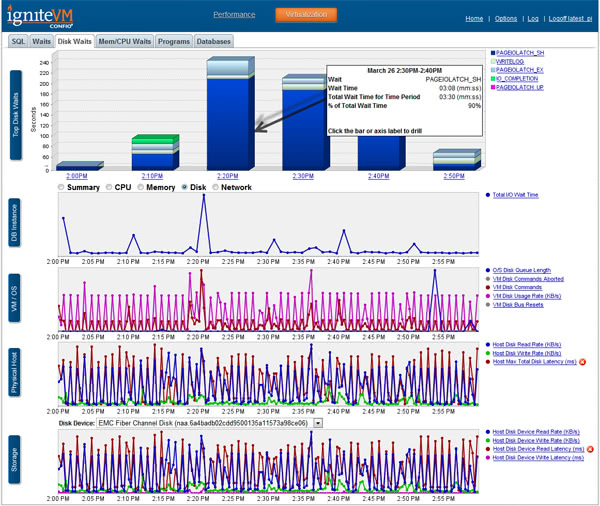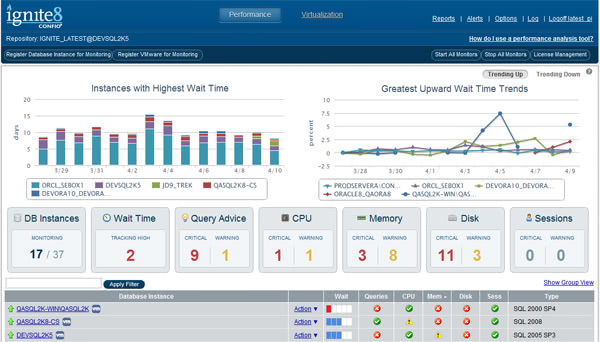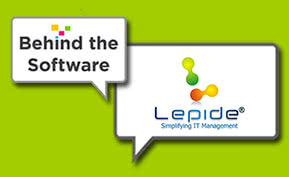IT Management
Confio Brings the Next Level in Database Management Solutions

IT professionals continue to face considerable challenges. The explosion in big data’s popularity means more data centers, which means a lot more data to manage. And despite forecasts of (slightly) increased IT spending 2013, many network admins are finding themselves having to deliver more performance with fewer resources. We talked to Confio Software founder and CEO Matt Larson to find out how Ignite can help carry out that task.
For more information specific solutions in this segment be sure to explore our IT Management Top 10 reports.
What was the inspiration behind Confio? Was there a specific business need out there that wasn’t being addressed?

WEBSITE: www.confio.com
FOUNDED: 2002
LOCATION: Boulder, Colorado
CUSTOMERS: Boeing, HP, Seagate, ING, Scotiabank, Cisco WebEx
There was. Essentially, the current tools at the time, and this is still the case for most tools that are monitoring the performance of databases, were looking at things from what we call a “health metric” perspective. So they’d look at the database, and the database would have all of these statistics. It would say, this is how much memory you’re using, this is how much CPU you’re using and so on. So they had all these dials and gauges. At that time, when the users had a problem, the user says, hey, I’m trying to use this database and it’s slow; really, what they’re doing is using an application, and the application’s using the database. But hey, my application’s slow and pretty sure it’s the database, what’s wrong?
I was a database administrator (DBA), and we’d have to look at it and kind of go, well, all the gauges say it’s healthy, so we don’t know what’s wrong. All we know is we don’t see any problems inside the database. Well, the user’s sitting back there saying, well, that doesn’t help me very much; because, let’s say, my transaction is supposed to happen in three seconds and now it’s taking two minutes, it doesn’t really help when all you guys do is tell us that the database is healthy. I don’t care as a user if a database is healthy; all I care about is the fact that my transaction is now taking a lot longer than it’s supposed to.
What I realized is with these building blocks we could essentially build a system that would allow monitoring from the perspective of the end-user, from what we call a “response time” perspective, or sometimes we call it “wait time.” So rather than just saying, these are all the metrics that show if a database is healthy or not; what if we were able to do was come up with a system that said, OK, this user’s transaction normally runs in three seconds, and now it’s running in 30 seconds–where did the extra 27 seconds go? What was that transaction waiting on inside the database during those 27 seconds?
The software, sort of, was able to come back and say, well, here’s the problem. It’s taking an extra 27 seconds because it’s conflicting with another user, which is called a lock inside of a database, so there’s locking issues; or it’s taking longer because the disc drive is going slower today than yesterday. It turns out that there’s literally thousands of these different bottlenecks that can happen. I mean, you are literally making a one out of a thousand guess as to what it is, or you’re looking for hints, which you can kind of get some hints from the metrics, but it’s certainly not obvious to you.
So with Ignite we made it very, very simple. We have a simple interface where it just makes it very obvious–hey, the user was waiting three seconds yesterday, they’re now waiting 30 seconds, and this is exactly where that extra 27 seconds is going, whatever that bottleneck might be.
So if there’s a bottleneck or hitch in response time, Ignite can give you a list of reasons as to why it’s happening?
That’s right. An analogy that we’ve used a lot is, if you think about your car–your car has all sorts of metrics related to it. You’ve got the metrics on your dashboard, like, your RPM and your engine temperature. There’s actually a lot of other metrics that are being collected in your car’s computer, like how many times the fan is turned on, the tire pressure in your tires–there’s all sorts of these metrics. But if I said to you, why is it taking you so long in your commute to work, none of those metrics really matter most of the time. I mean, unless your car is really having significant issues, that’s not what slowed you down on your way to work today.
It was you ran into a bottleneck–it was not the health of your car, it was a bottleneck, and it turned out that there was a wreck or something, or there’s a light that always stays red for a long period of time on your commute, or it could be a variety of other things. But that’s what it is–it’s almost certainly not the case that if your tire pressure’s a little low on the car, if we give you better tire pressure, you’re going to get to work faster. No, you’re not.
What are some of the primary reasons that you get a lot of these latency spikes in the input/output, especially with virtual databases? Is it that these systems have limited throughput now?
No, the total throughput on a per server basis has actually gotten better. The problem in virtualization is that you can put on, let’s say, 10 virtual servers onto one real server, a physical server. In the past, before virtualization, one physical server only had one operating system on it–it only acted like one server, so you only had enough activity from one server. That server never conflicted with any other servers because it completely controlled the hardware. I mean, so think about your laptop–your laptop is still like the old way, where you have one operating system, probably a version of Windows, and that it is. Windows has complete control over that disc drive, has complete control over that CPU and so on. Windows is really good at, sort of, sharing the resources between your various applications. So, when Outlook needs resources versus Word, Microsoft Windows, your operation system, knows how to juggle those, and it juggles it assuming it has full control over the hard drive and CPU and network card and so on.
When you change that, and you basically say, OK–and you could do this with your laptop, I wouldn’t recommend it–but you could turn it into a VM server, and you could actually have 10 versions of Windows running on there, on that laptop of yours. Well, now suddenly nobody really knows what the other people are doing; you know, one version of Windows is running its stuff, and it’s trying to balance and control thinking it has full control over the machine, but it doesn’t. So it’s doing something, perhaps using up–it’s really working your hard drive hard, it’s doing a lot of reads and writes to your hard drive. Well, the other virtual machines on there, they’re not even aware of that, they’re not even aware that this other VM is there, let alone that it started using up all the hard drive. Then they get confused, because they go–wow, I don’t understand.
Our applications inside of our operating system, when they were using the disc, it was fast just five minutes ago; suddenly, it’s really slow and we have no idea why and it’s confusing, why is it suddenly slow. Well, it’s slow because the other virtual machine was using it, and because it’s just that things weren’t designed that way. So virtualization takes the complexity up in order of magnitude, which is why–and this kind of gets to a broader issue–whenever you have a big technology shift, what essentially happens in the tools market–in the software tools market, is you reset the thing. So if you had tools–this is like in our industry is going through this transition–if you had tools that were coded for these stand-alone environments where everything really did work the way that it used to; then as soon as everything changes to virtual, those tools become outdated.
So suddenly, you almost have a brand new market. People are looking for brand new tools because they need databases on virtualization now, so they start looking at brand new tools. The old tools aren’t even compatible anymore. So the market, sort of, recreates; it starts all over again. They throw away the old tools, they start buying new tools; whatever vendors are there already with virtualization aware tools, for example, can take advantage of it. That’s us. I mean, we do that. For example, if your database is running inside of one virtual machine, and another virtual machine starts hogging up the shared physical resources, it starts hogging up the disc drive–well, we’ll be able to tell that database–hey, that’s what’s happening, by the way, this other virtual machine is actually causing you trouble. So if you want to get your database performing well, you need to move that other one somewhere else or something like that.
Have you noticed any strong correlations in the sorts of organizations using your products? Any specific industries or company sizes, or is it really across the board?
It’s really across the board. Pretty much any company, after you get above a certain size, let’s say, $50 million in revenue, will have databases. The bigger you grow, the more databases you have. Databases change constantly. Every day, people wake up and decide to ask their database a different question. They want to look at the data in a different way, or they want to start putting new data into it or taking new data out.
Now, obviously, industries with high volumes of information, like insurance, telecom, big data-type scenarios those are probably our biggest customers, but generally it’s across the board.
You started out with an internship at Oracle in Colorado. How has the well of knowledge you built up in working with Oracle technologies affected the way you’re operating Confio today?
Well, I think the main thing is that since I’ve been in that position, the position of our customer, which is a database administrator (DBA), and I’ve personally felt the various pains that you have inside of that situation, the various problems that you run into and so on, I think it just makes me–the ability to be empathetic like that makes it so that I can see products we might release or features that we might be working on, and have a good sense that this would either be something that would not have been valuable to me at all had I still been back in that position. Now, obviously, we still back those hunches up. We’ll go verify with customers and make sure that people really do feel that way. But just having lived in their shoes for a number of years helps to better understand what their problems really are.
What’s the biggest challenge you guys are facing right now, either business-wise or technology-wise, and how are you addressing it?
You know, that’s a good question. I don’t know right now that we feel like we’ve got–that we really have a big problem in front of us. I think we–I don’t mean to sound pollyannish, but I think we feel that we sort of have more opportunities that we just need to execute on. If we can execute well then we’ll do it. We’ve grown pretty quickly. We will grow again very quickly this year. So, you know, I don’t know that we, per se, have a big problem that’s worrying us. It’s just more about how do we execute so that we can live to our full potential?
Where do you see database technology and the database management industry going in the next few years?
Well, I think databases hosted in the cloud are probably the biggest shift that’s happening right now. There’s a lot of challenges that come with that, because on the one hand, I think CIOs want to have that stuff have the cost of databases go down dramatically because they’re very expensive, and they see the cloud as a benefit of that. But the problem with that is that suddenly you’re now trusting somebody else with this data. It’s incredibly important and very scary for a CIO to say, well, what happens if I give my data to Amazon and they leak our customer list to everybody?
I think there’s a lot of data security issues that people are worried about with databases in the cloud. I think there’s reliability, as well, where you’ve had outages with Amazon’s cloud, for example, that in theory was never supposed to happen, and yet it did happen. There were major outages, so I think that alarms people as well. But I think over time, more and more people will be comfortable with it being in the cloud and there’ll be some solutions for that. That’s probably the biggest change that I can think of.
What makes you most excited to be working at Confio?
You know, I think the most enjoyable part is the people here, the employees here at Confio. I mean, I think we’ve really worked very hard to put together a great team of people. So I just enjoy coming in every day and seeing all the different people and interacting with everyone. I think we just have a good work environment, where we just have a lot of really sharp people working here who are working hard to make our customers successful. So from just a pure enjoyment perspective, I’d say that’s it.
If you want to find out more about some of the other IT management systems out there, try taking a look at our exclusive Top 10 ITSM Software report. You can also pay a visit to the Business-Software.com IT management resource page, the hub for all IT management-related content form us and our network of guest contributors.







